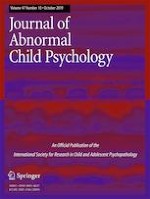06-04-2019
Negative Parenting Moderates the Prospective Association of ADHD Symptoms and Youth Social Problems
Gepubliceerd in: Research on Child and Adolescent Psychopathology | Uitgave 10/2019
Log in om toegang te krijgenAbstract
Although ADHD and negative parenting are established predictors of youth outcomes, their independent and interactive effects on youth social functioning remain unclear. We tested childhood ADHD symptoms and negative parenting as independent and interactive predictors of prospective change in social problems across a four-year follow-up. At baseline, families of 221 (33% female) children with (n = 94) and without ADHD were rigorously assessed including observed positive and negative parenting behavior, youth ADHD symptoms, as well as multi-informant ratings of youth social problems at multiple occasions. Based on multiple regression with robust standard errors and full-information maximum likelihood procedures to address missing data, ADHD symptoms positively predicted social problems, even with control of observed parenting behavior, child age and sex, oppositional defiant disorder symptoms, and baseline social problems. Additionally, a child ADHD symptoms x negative parenting interaction uniquely predicted separate parent- and teacher-rated social problems where ADHD symptoms positively predicted social problems exclusively in the context of high (+1SD) and very high (+2 SD) negative parenting, respectively. When ADHD was separated into distinct dimensions (i.e., inattention, hyperactivity), an interaction between inattention symptoms and negative parenting approached significance such that inattention symptoms positively predicted parent-rated social problems in the context of high negative parenting. We discuss the interaction between parenting and ADHD symptoms in predictions of youth social problems and implications for intervention.
